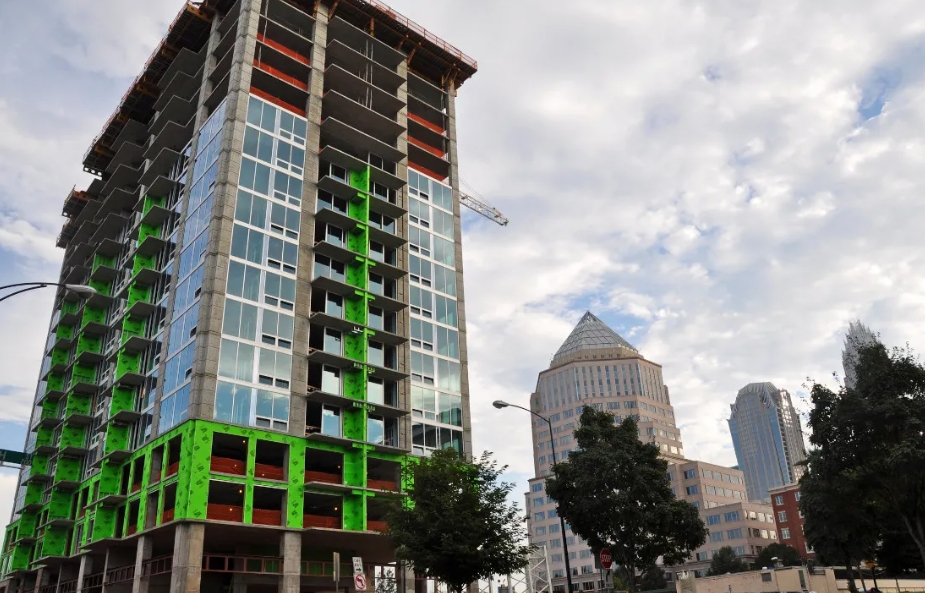
A high-rise building under construction in downtown Raleigh in 2014. (Credit: James Willamor / Creative Commons)
by Elizabeth Ouzts, Energy News Network
A new North Carolina climate plan outlines actions that would help curb greenhouse gas pollution by nearly two-thirds by 2030 — surpassing a state goal and meeting scientists’ recommendations for how to avoid the worst impacts of global warming.
The state is already on pace to cut emissions just over 40% compared to 2005 levels. But the steps outlined in the new blueprint, crafted as part of the federal Inflation Reduction Act, would slash heat-trapping pollution even further.
If sustained over the ensuing decades, the measures would also bring the state closer to zeroing out its climate footprint by midcentury, though officials stress that doing so would require “significant will, funding, and effort.”
Finalized earlier this month after weeks of webinars, community meetings, and other forms of public feedback, the Priority Action Climate Plan covers six areas of the state’s economy: transportation, electricity, buildings, industry, waste, and lands. The action items are “implementation ready,” officials say, and not dependent on new state laws or policies.
By far, the biggest opportunity for curbing pollution is in the building sector. Ramping up support for low-income weatherization assistance, energy efficiency upgrades in government buildings, and other measures to reduce energy usage per square foot could account for 60% of pollution reductions anticipated by 2030.
“The buildings sector is one with a lot of low-hanging fruit that hasn’t been widely addressed to date,” said Sara Edwards, a spokesperson with the North Carolina Department of Environmental Quality, which took the lead in crafting the action plan.
Edwards noted the state’s 2009-era residential building code, which is frozen in place until 2031 thanks to a law passed last year. “Even new housing stock coming online is not as energy efficient as it could be,” she said.
Many older commercial and public buildings lack up-to-date lighting and energy management systems, she added. “State agency buildings alone have identified over $200 million of energy saving projects that are waiting for funding to implement,” she said.
“The same types of projects could be implemented at public universities and community colleges, as well as schools and local government buildings, resulting in significant ongoing savings to [state] taxpayers,” said Edwards.
Phasing out direct combustion of fossil fuels in buildings, such as from gas furnaces, could achieve another 36 million metric tons of emissions, almost a quarter of the cuts.
Recommendations in the other five sectors combined could result in a fifth of the reductions, or a total of 29 million metric tons of carbon dioxide (or the equivalent).
In the transportation sector, today the state’s largest source of greenhouse gasses, priority steps include facilitating transportation choices other than cars and increased deployment of electric vehicles and charging infrastructure.
To curb emissions from electric utilities, the plan focuses on boosting solar panels on homes, local government properties, and other small institutions, complementing a state law requiring Duke to ramp up larger-scale renewable energy investments.
The blueprint also outlines programs to increase industrial efficiency, better capture methane gas from landfills, and restore and protect peatlands and forests, vital for their ability to capture and store carbon.
North Carolina’s Department of Environmental Quality joined 44 other states in submitting its priority climate action plan, according to an announcement this week from the Environmental Protection Agency.
Charlotte, the Triangle, and the Eastern Band of Cherokees were among nearly 200 metropolitan regions and tribes around the country who submitted their own plans, as well.
The documents set the stage for the next phase of the federal Climate Pollution Reduction Grant program. With the blueprints as their guide, tribes, states, and large metropolitan regions will now work to apply for $4.6 billion in competitive grants for implementation.
As the Biden administration races to get Inflation Reduction Act funds out the door this year, the deadline for those proposals is April 1.
Meanwhile, the Department will take comments on the priority plan until June 3, which it says will inform yet another strategy document required under the Inflation Reduction Act: a comprehensive climate action plan, due in June 2025.
“Throughout this process,” Edwards said, “we’ve done public outreach and stakeholder engagement. That’s going to continue throughout. It’s not just like we’re going to drop this document and not take public comment.”